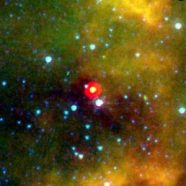Baby star
Astronomers have observed the earliest twinkles ever picked up from a newborn star.
By Emily Sohn
In Hollywood, a hit movie can make an actor a big star overnight. In outer space, star birth takes a bit longer.
Astronomers have now observed what they suggest is a baby star in the process of being born. If they’re right, it’ll be the earliest twinkles ever picked up from a newborn star.
 |
|
The red disc in the center of this infrared image may be the least massive, youngest newborn star ever recorded.
|
| Evans, et al./Spitzer |
Through a telescope in outer space, the object looks like a faintly glowing body. Astronomers from the University of Texas in Austin spotted it with the Spitzer Space Telescope, which orbits Earth.
The object lies 6,000 light-years from Earth in a thick cloud of gas and dust called L1014. In the past, L1014 has appeared totally dark. When the Spitzer team recently pointed the telescope at the cloud’s center, though, they were surprised to see a spot of infrared light that looked like “a big, red, bloodshot eye.” Infrared light isn’t visible to the human eye, but all objects absorb and give off this form of radiation.
At such an early stage in its life, the object has a tiny mass. Compared to our sun, it weighs in at less than one-thousandth the sun’s mass.
No one is sure what will happen next. One possibility is that the glimmering body will gather together enough gas and dust to become a true star. It’s also possible that the object will run out of steam and instead turn into a faint, cold object known as a brown dwarf.
In the star nursery, only time will tell.
Going Deeper:
Cowen, Ron. 2004. First light: Faint object may be youngest star detected. Science News 166(Nov. 13):309. Available at http://www.sciencenews.org/articles/20041113/fob5.asp .
Additional information about the discovery of what may be the youngest newborn star ever detected can be found at www.jpl.nasa.gov/news/news.cfm?release=2004-275 (NASA Jet Propulsion Laboratory).
You can learn more about the birth of stars at www.allaboutspace.com/subjects/astronomy/
stars/lifecycle/starbirth.shtml (Enchanted Learning Software). Information about stars can be found at starchild.gsfc.nasa.gov/docs/
StarChild/universe_level2/stars.html (NASA Goddard Space Flight Center).







